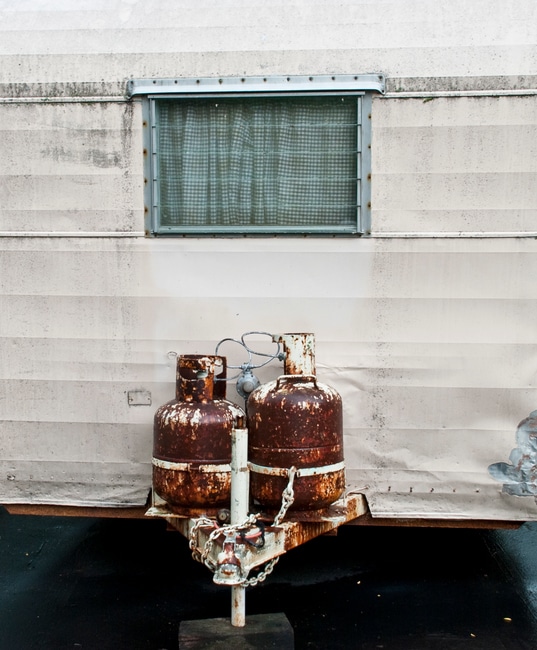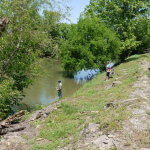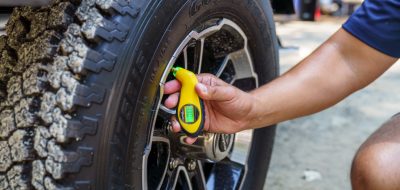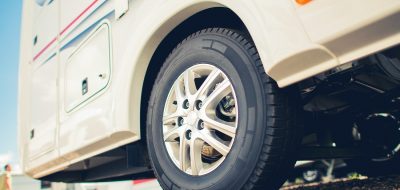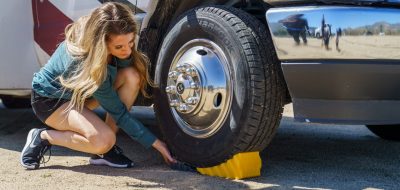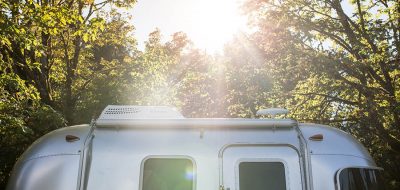 Hi folks! Hope you’re getting your RVing ready for a summer of fun! We’ll talk about tires, generators, and fussy propane tanks this month. Remember to send your RVing questions to [email protected].
Hi folks! Hope you’re getting your RVing ready for a summer of fun! We’ll talk about tires, generators, and fussy propane tanks this month. Remember to send your RVing questions to [email protected].
Hi, Mark
We have a dual tank, automatic switching regulator on our travel trailer. It is only a few years old but it seems that every spring we have trouble getting the gas to flow properly from the tanks to the heater, stove, etc. the first time or two after it has been in storage. The gas is super slow and usually the flame will go out (the gas literally sucks the flame out) many times, over several hours, before we can get a steady flame. Is this a regulator defect or is there something we are missing when we winterize our travel trailer? Any suggestions would be great. Thanks, Jennifer
Hi Jennifer
It’s possible that the problem is caused by the excess flow safety device built into the propane tank valves. This is supposed to prevent propane flowing at high rates into a leaking or open pipe. This happens with BBQ grills too. For example, if you hook up a propane tank to a grill and one of the grill burners was left on, when you open the valve on the tank, only a small amount of gas will flow. That’s the tank’s protection device operating, because it sensed a high flow rate when you opened the valve. The fix is to close the grill burner valves, and then close the tank valve, wait a moment, then open it again. Now gas will flow normally. In the case of your travel trailer, when you first open the propane tank valves after a long storage period, the lack of pressure in the system can cause the same thing to happen. Just make sure all the propane appliances are off, and then close the tank valves, wait a few moments, then open them again. I’ll bet that will fix it, but if it doesn’t, it’s possible that the regulator is sticking or developing a problem. Regulators are not repairable, so you would need to replace it as an assembly. Thankfully, those regulators are easy to access and replace, and aren’t terribly expensive. If you do replace the regulator yourself, be sure to spray or brush some soapy water on all the connections to test for leaks. If a connection is leaking, you’ll see bubbles.
Hi, Mark,
I have a 28′ Komfort travel trailer. I always fill up the water tank about half way when I travel. When I hook up in a park including water supply, is their water going through my tank or is it a direct line to the spigot at the sink? Also, how do I sanitize with Clorox bleach and how much do I use and should I let it slosh around while traveling? Thanks, Ken
Hi, Ken,
When you hook the hose up to the city water inlet, the water is essentially bypassing your fresh-water tank and pump. The city water inlet is tied directly into the cold-water supply line after the 12V water pump’s outlet. The only way that you will draw any water from your fresh-water tank is with the 12V water pump running. Depending on your rig, you may either fill the fresh-water tank through a filler on the side of the rig, or by opening a valve to allow the city water connection to fill the tank. (Or both, every RV is unique in the way they are plumbed). The only reason I bring that up is that it affects how you get the sanitizer into your tank. To sanitize the tank and the fresh-water system, follow your RV manufacturer’s instructions or do the following: Prepare a chlorine solution in a 1-gallon jug by adding 1/4 cup of Clorox or Purex household bleach (5% sodium hypochlorite solution) for each 15 gallons of tank capacity. Top off the jug with water, and then pour the solution into the tank through the fresh-water tank filler. If your rig does not have a water fill on the side, and uses a valve, you’ll need to drain your fresh water hose, connect it to the spigot, and then carefully pour the needed amount of bleach for your tank capacity into the hose end. Then, hook up the hose to the city water inlet on the rig, turn the valve to fill the fresh-water tank, and turn on the spigot at the pedestal. If everything works right, the water pressure will force the bleach into your fresh water tank. This method is a potentially risky from a “bleach spraying around” standpoint, so use it at your own risk. It does work if you do it correctly. Once the bleach solution is in, completely fill the tank with fresh water. Turn on the pump, open each faucet, and let it run until the entire fresh-water system is filled with the bleach/water solution. You should be able to smell chlorine strongly at each faucet. Allow it to stand at least four hours; overnight is better. Finally, drain and flush the tank and fresh-water system with potable fresh water. It’s a good idea to sanitize the water system after the rig has been in winter storage, out of use for several months, or when the water starts to get an odor or taste in it.
Hi, Mark,
In your training seminar, it was said that tires would last “only” 5-7 years, so be sure to replace them then, even though the tread is not worn. We’ve been full-timing in our 5th– wheel for a year now, typically staying a week in a park and then moving on. We put about 20,000 miles on the truck in the first year, obviously less on the trailer as we were unhitched part of the time. I’m guessing about 12,000 on the trailer. Our trailer tires are wearing along the outside edges of the tread, especially the rear ones (2 axles). By observing the wheels while backing into a space in the RV parks, we can see that the rear tires slide sideways during the turn, and we think that is causing the excessive wear. It seems worse on paved surfaces and when the spaces are 90 degrees to the street, and we often leave some rubber on the street while trying to park. More so on narrow streets and narrow spaces, as the truck has a wide turning radius and there is a lot of backing and filling. The front truck tires are showing the same sort of wear, though much less. Is this sort of wear normal for the way we use the RV? Is the 5-7- year recommendation based on using the trailer for only 2-3 weeks a year, and we should expect to wear them out in 2-3-4 years, depending on mileage? Thanks, John and Vicki
Hi, John and Vicki,
There are several possibilities. Wear on the outside of the tread can indeed be caused by the scuffing of the tires during sharp turns, but that wear is usually fairly light. If you are seeing significant wear on the outer edges, it could be caused by operating the RV over its designed weigh limitations or by alignment issues on the trailer axles. If you are sure you are not overweight and are seeing significant wear patterns forming, it may be a problem with the axles/suspension. It is easy to bend axles or suspension components with a curb strike, or even by backing into a really tight spot and jackknifing the trailer really tightly. That misalignment can cause odd wear patterns. Try to avoid really tight turns when backing by lining up on the site as straightly as possible before backing. It is better to work back and forth several times to get into a better position rather than to try to do a really sharp backing turn in one shot. As far as tire life is concerned, your RV tires should be watched for signs of deterioration, especially when they reach and pass the 5-year-old mark. All RV tires should be replaced at 7 years of age, regardless of how they look or how much tread is left on them. Usage really doesn’t make much difference because tires degrade over time whether they are sitting still or rolling. Trailer tires have a tough life and tend to wear at a faster rate than other RV tires. If the tread reaches the minimum safe depth (generally stated to be 3/32”), the tire should be replaced, regardless of age. RVs typically run at, or close to, or even over, their maximum load ratings 100 percent of the time. That is a very demanding tire application. If you do have a tire failure or a tread separation, it usually does costly damage to the RV, so if your tires are getting old, worn out, or show any sign of deterioration or damage, get some new ones!
Hi, Mark,
Is it okay to periodically run the generator while still hooked up to shore power or would that be harmful to the electrical system? Thanks, Larry
Hi, Larry,
I’m assuming that you want to run your generator periodically to exercise it. That’s a good idea, as it will keep your generator operating reliably. Do it once a month for at least an hour under a ½ to a full load. Onboard RV generators typically use an automatic transfer switch to disconnect the rig’s AC power cord and connect the output of the generator to the rig’s breaker panel when the generator is in operation. This switch will prevent the output of the generator and the shore power from interacting, but there will be a brief interruption in AC power throughout the rig when the transfer switch activates. This can be hard on things like air conditioning compressors and electronic devices if they are operating when the interruption occurs. My suggestion is to shut down these kinds of appliances and devices before starting the generator, then restart some loads after everything has a minute to stabilize. Follow the same procedure when shutting the generator down. In fact, it’s a good idea to let the generator run for a few minutes with no load on it to allow it to cool down before stopping it.
Mark:
I have been trying to find out details about using generators during stays in unserviced parks. I have found references to certain hours that vary by park and noise limitations that are not fully defined. I have a 30-ft. 2006 Montana TT, so a built-in Onan-caliber generator is not a real option. I currently own a small two-stroke generator that I would like to bring with us when we cross the country this summer. I read that national parks have a noise limitation (is it 60 db?), but I can’t find what distance from the generator that limitation applies to. (A commercial jet can be 60 db if you get far enough away!) Also, are there any restrictions that would prevent me from using my two-stroke generator (smoke and all) in national parks that allow generators? Are there any special rules for California (or any other state, for that matter) regarding two-stroke generators? I have spent hours on the NPS site and elsewhere, but I can’t find this information. Can you help? Thank you, Gordon.
Hi, Gordon,
The National Park Service (NPS) noise limit for generators is 60 dba at 50′ from the source. Actually, the Code of Federal Regulations, Title 36, Volume 1, states (in part) that “The following are prohibited:
(1) Operating motorized equipment or machinery such as an electric generating plant, motor vehicle, motorized toy, or an audio device, such as a radio, television set, tape deck, or musical instrument, in a manner: (i) That exceeds a noise level of 60 decibels measured on the A-weighted scale at 50 feet; or, if below that level, nevertheless (ii) makes noise which is unreasonable, considering the nature and purpose of the actor’s conduct, location, time of day or night, purpose for which the area was established, impact on park users, and other factors that would govern the conduct of a reasonably prudent person under the circumstances.”
I’m not able to find any specific restrictions within the NPS regarding 2-stroke generators, but I suspect that the “impact on park users” clause above might apply to exhaust smoke. I do know that the sale of outdoor products utilizing 2-stroke engines is no longer legal in some states, and many public lakes and waterways have been trying to ban 2-stroke outboards and jet skis for years. There are a number of quiet alternatives available, like the Honda EU-series generators, and you’d probably be happier in the long run with a generator that is quiet and smog-free. I’m sure the neighbors would be happier, anyway! It’s also important to observe “generator hours” anywhere you are parked. Most parks restrict operation of generators of any type to specific hours during the day.
 Founded in 1978, the Escapees RV Club provides a total support network that includes a wide variety of services and opportunities:
Founded in 1978, the Escapees RV Club provides a total support network that includes a wide variety of services and opportunities:
- Mail Service- Escapees offers the largest private mail service in the country. Members are able to personalize their mail delivery with multiple options. Custom sorting options, delivery schedule and even mail scanning. We make it easy!
- Mapping Tool- Plug in your starting point and destination, and let us do the rest! Our mapping tool will show you discount parks along your route, as well as trusted commercial members and endorsed vendors to help you with all of your needs along the way.
- Education- From our annual Escapades to our discussion forum, we help you connect with fellow RVers to share experience and knowledge. For the hands-on learner, RVers’ Boot Camp is a great way to learn about RV operation, safety and maintenance. Our award-winning magazine is also a great resource for peer-to-peer advice from fellow RVers and industry experts.
- Community- When you see an Escapees sticker on a rig, you know you’ve found a friend. Escapees hosts a variety of events throughout the year, including convergences, excursions, chapter rallies and Escapade. Each of these offers the opportunity to connect with other RVers and make new friends.
A complete listing of all Escapees events and a comprehensive list of member benefits are found at www.escapees.com

